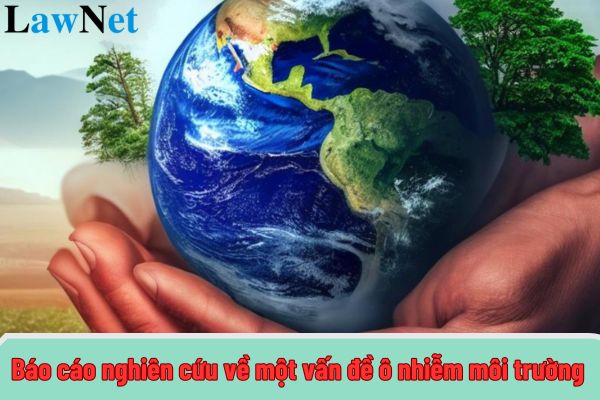What is the most detailed sample research report on environmental pollution in Vietnam? In 2024, how many students does one class at the upper secondary level in Vietnam have?
What is the most detailed sample research report on environmental pollution in Vietnam?
>>See more: What is the sample research report on a natural or social matter that you and many others are concerned about? What are the core objectives of general education?
Students can refer to the following most detailed sample research report on environmental pollution in Vietnam:
|
The most detailed sample research report on environmental pollution
I. Introduction
Air pollution is an increasingly serious environmental issue in major cities in Vietnam, significantly affecting public health and quality of life. Hanoi and Ho Chi Minh City, the two largest cities in the country, are both facing severe air pollution, especially during winter and hot sunny days when fine particulate matter (PM2.5) levels exceed permissible limits. According to the Ministry of Natural Resources and Environment, air pollution levels in Hanoi have surpassed the World Health Organization (WHO) safety thresholds for many years, and Ho Chi Minh City is not much better, with Air Quality Index (AQI) levels often at "unhealthy" levels (Ministry of Natural Resources and Environment, 2023).
II. Research Purpose
This report aims to survey the air pollution situation in Hanoi and Ho Chi Minh City, analyze the main causes of pollution, and propose effective mitigation measures.
III. Research Methodology
The research method uses data from air monitoring stations in large cities, analyzing key pollution indicators such as PM2.5, PM10, NO2, CO, SO2, and O3 throughout 2023. Data was collected from official sources of the Ministry of Natural Resources and Environment (2023), previous studies, and evaluation reports from international organizations like the World Health Organization (WHO, 2023).
IV. Research Results
Air Pollution Levels in Hanoi and Ho Chi Minh City
Hanoi: According to data from monitoring stations, PM2.5 levels in Hanoi can reach up to 150 µg/m³, while the WHO safety threshold is only 25 µg/m³. During each winter, the AQI frequently surpasses 150, severely affecting residents' health. This pollution is mainly due to emissions from traffic, industry, and straw burning in suburban areas (Ministry of Natural Resources and Environment, 2023).
Ho Chi Minh City: Although not directly affected by winter like Hanoi, Ho Chi Minh City also faces severe air pollution, especially during rush hours. PM2.5 levels in Ho Chi Minh City range from 50 to 70 µg/m³, and AQI often exceeds 100 many days a year, affecting those with respiratory issues, children, and the elderly (Department of Natural Resources and Environment of Ho Chi Minh City, 2023).
Main Causes of Air Pollution
Traffic: Hanoi and Ho Chi Minh City have very high traffic density, especially motorcycles, the primary means of transportation for the population. Motorcycles not only emit CO2 but also spread a large amount of fine particulate matter PM2.5 and NOx (nitrogen oxides), increasing pollution levels. A study by Ton Duc Thang University shows that about 60% of air pollution in major cities comes from traffic, especially during peak hours (Ton Duc Thang University, 2023).
Industrial Activities: Industrial zones in provinces surrounding Hanoi and Ho Chi Minh City are significant sources of emissions. Factories producing cement, steel, food processing, and mineral extraction release a large amount of dust and toxic gases. These not only cause air pollution but also affect water and soil resources (Government of Vietnam, 2023).
Waste and Agricultural Burning: Uncontrolled burning of waste and straw in suburban areas, along with shortcomings in the household waste treatment system, exacerbates air pollution. Agricultural waste such as plastics and chemicals also pollutes when not properly treated (Tuoi Tre Newspaper, 2023).
Impact of Air Pollution
Public Health: Air pollution is a direct cause of respiratory diseases such as pneumonia, asthma, and lung cancer. These diseases are on the rise, especially among children and the elderly. According to the Ministry of Health, the number of respiratory disease cases in Hanoi increased by over 20% in 2023, while Ho Chi Minh City also reported a 15% increase (Ministry of Health, 2023).
Economy: Air pollution not only affects health but also causes significant economic losses. A study by the World Bank shows that air pollution in Vietnam causes economic losses of approximately 5% of GDP each year, mainly due to medical costs and loss of work productivity (World Bank, 2023).
V. Mitigation Solutions
Improving public transportation: the Government of Vietnam needs to promote the development of public transport systems such as buses and subways to reduce the density of private vehicles, especially motorcycles, on the roads. At the same time, emissions control is essential for vehicles, especially older ones (Thanh Nien Newspaper, 2023).
Promoting green production: Industries need to switch to using clean production technologies and apply emission reduction measures. the Government of Vietnam can implement tax incentives and financial support policies for businesses making this transition (Ministry of Industry and Trade, 2023).
Raising community awareness: Campaigns should be launched to educate and inform about the harm of air pollution and health protection measures, such as limiting outdoor activities on heavily polluted days and wearing masks outside (World Health Organization, 2023).
VI. Conclusion
Air pollution in Hanoi and Ho Chi Minh City has become an urgent issue, requiring the collective effort of the entire society to mitigate. Solutions such as improving public transportation, enhancing clean production technologies, and raising community awareness are necessary measures to protect health and improve the quality of life for residents.
References:
Ministry of Natural Resources and Environment (2023). "Report on air pollution in major cities of Vietnam."
Department of Natural Resources and Environment of Ho Chi Minh City (2023). "Report on the air quality in Ho Chi Minh City in 2023."
Ton Duc Thang University (2023). "Study on the impact of traffic on air pollution in Ho Chi Minh City."
Government of Vietnam (2023). "Industries and air pollution in Vietnam."
Tuoi Tre Newspaper (2023). "Air pollution and impact from waste burning."
Ministry of Health (2023). "Impact of air pollution on public health in Vietnam."
World Bank (2023). "Economic impact of air pollution in Vietnam."
Thanh Nien Newspaper (2023). "Solutions to improve air quality in major cities."
World Health Organization (WHO, 2023). "Global air pollution report."
|
*Note: Information is for reference purposes only./.

What is the most detailed sample research report on environmental pollution in Vietnam? (Image from the Internet)
In 2024, how many students does one class at the upper secondary level in Vietnam have?
According to Article 16 of the lower secondary school, upper secondary school and multi-level school charter issued with Circular 32/2020/TT-BGDDT, regulations regarding class at the upper secondary level in 2024 are as follows:
Classes
1. Students shall be divided into classes. Each class shall have a class monitor and deputy class monitors who are self-nominated or introduced by the homeroom teacher and elected by the students of the class at the beginning of each academic year or after each semester. Each class shall be divided into different student teams; and each team shall have a team leader and deputy team leader who are self-nominated or introduced by the homeroom teacher and elected by the team members at the beginning of each academic year or after each semester.
2. Activities in classes shall be carried out in a democratic, autonomous and cooperative manner. Each student shall proactively contribute to development of the operational plans of their team and their class with teacher’s assistance.
3. Chairpersons of provincial People’s Committees shall stipulate number of students in each class with the aim of reducing number of students in one class; ensure that each class at the lower secondary or upper secondary level has a maximum of 45 students.
4. Number of students in each class of a special school is provided for in organizational and operational regulations for special schools.
Thus, according to the regulations mentioned above, in 2024, each class at the upper secondary level must ensure no more than 45 students, with the specific number of students in each class determined by the President of the Provincial People's Committee.
*Note: The number of students in each class of gifted schools is specified in the organizational and operational regulations of gifted schools.
What are the regulations on manners and attire of the upper secondary school students in Vietnam?
Under Article 36 of the lower secondary school, upper secondary school and multi-level school charter issued with Circular 32/2020/TT-BGDDT, regulations on manners and attire of the upper secondary school students in Vietnam are as follows:
- Students must have appropriate, respectful, friendly and cultured manners and language that suit the moral values and lifestyle of secondary school students.
- Student’s attire must be proper, clean, tidy, appropriate for their age and convenient for learning and other activities at school. Depending on the capacity of each school, the school principal may decide whether to let students wear uniform and seek approval from the parent committee of the school.


